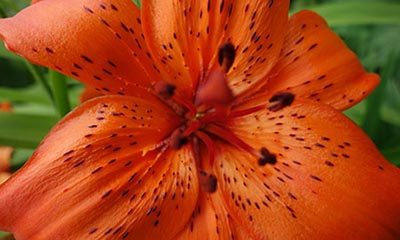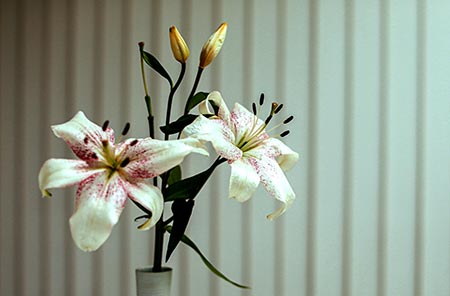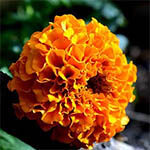
Daylily Meaning
Wondrous Myths, Symbolism & Devotion
Daylily flower meaning begins in ancient times. For the Chinese, the daylily means filial devotion to one’s mother. Beginning in the Victorian era with the language of flowers, daylily flower meaning includes “forgetting worries” and “flirtatious.”
Share this page with a friend!
Daylily Flower Meaning in Greek Myths
In ancient times, the lily was dedicated to Hera, the wife of Zeus. A less then faithful spouse, Zeus fathered his son Hercules by the mortal woman Alceme. Although the mother was mortal, Zeus wanted his son to have divine powers.
Origin of the Milky Way Galaxy
For this reason, he brought the baby to Hera while she slept to allow the baby to nurse and receive divine powers through her milk. When she awoke, she flung the child from her in wrath. Her milk spewed across the universe, forming the Milky Way. Some drops of her milk fell to earth. These drops became the first lilies.

Daylily Flower Meaning: Name Origin
The botanical name for daylilies comes from the Greek word “hemera” meaning “day.” The daylily is aptly named due to the the fact that the flowers open at sunrise and wither at sunset. Daylily blossoms literally last for one day only!
Species of Lilies
Lilies have long been treasured for their beauty and strong floral scent. The lily family includes flowers with six petals. Daylilies have two layers of three petals each. There are 80-100 species of lilies, most of which are native to Asia, Europe, and North America. The bulbs of lilies are a starchy root that have been eaten for ages in China.
Worldwide Popularity of Lilies
The daylily plant produces flowers each day for four to five weeks. Daylilies are popular worldwide, with over 60,000 species of lilies. Water lilies are a separate type of lily and family with 58 species of its own. True lilies grow from a planted bulb. The Stargazer lily is known for its fragrance and usefulness as cut flowers.
Names of the Daylily in China
The day lily has many names in China. When it has a cheerful position, the flower is called “Wong Yu,” meaning “Forgetting Worries.” As an omen for expectant mothers who wish for baby boys, the flower is called “I Nan,” meaning “Suited for A Boy.” In this way, lilies represent the relationship between a mother and son. For this reason, the lily is worn by many mothers.
Catholic Daylily Meaning
In the Western world, the lily is connected to the Virgin Mary, symbolizing purity and innocence. Additionally, Lily is the most popular of all flower names for girls, exceeding other flower names like Daisy, Rose, Alyssa, Cassia, Camellia, Poppy and Myrtle.
History of the Easter Lily
The Easter lily is the most well-known and popular variety. The Easter lily is native to japan. A soldier named Louis Houghton brought the lily back to America from Japan in 1919. He shared the bulbs among his friends and fellow gardeners. When WWII broke out, Asian sources for the bulbs became scarce and expensive.
Modern Lily Production
American nurseries took on the plant, with over 1,200 nurseries producing Easter lilies by 1945. Today over 95% of all Easter lilies are grown in ten farms in California and Oregon in the United States. Easter lilies are grown in greenhouses under forced conditions so that they will bloom at Easter. The cultivar usually grown for Easter is called “Nellie White.”

Daylily Flower Meaning by Color
In addition to traditional daylily flower meanings of forgetting worries, filial devotion and flitaciousness, daylily flower meaning can also change based on color. Common daylily colors include white, yellow, pink, red and orange. Typical meanings are listed below:
White Daylily Flower Meaning: White lilies symbolize purity, innocence, and tranquility. Many night-flowering plants are white, symbolizing the feminine energies of the moon. White awakens creativity and stabilizes energy, giving a general boost that amplifies all other colors. White flowers include daylilies, gardenias, alyssum, and baby’s breath.
Red Daylily Flower Meaning: Red lilies symbolize passion and love. In addition, the color red represents the will to win, love of sports, and the survival instinct. Popular red flowers include poppies, poinsettias, daylilies, tulips, pansies and zinnias.
Pink Daylily Flower Meaning: Pink lilies symbolize prosperity, abundance, and joy. Most pink lilies are the Stargazer hybrid. Pink is related to warmth and love, gentleness, beauty, and an outward orientation. Pink is believed to awaken compassion, love and purity.
Yellow Daylily Flower Meaning: Yellow lilies symbolize thankfulness. Sunshine yellow flowers stimulate clear thinking. The color meanings of yellow are enthusiasm, confidence, cheerfulness, sense of humor, fun, optimism and intellectuality.
Orange Daylily Flower Meaning: Orange lilies symbolize confidence, pride, and wealth. Orange daylilies include Tiger Lilies recognizable for their unique brown spots. Orange flowers raise the spirits and symbolize the quality of joy. Cheerful orange flowers convey warmth, fire, energy, and vitality. Common orange flowers include marigolds, daylilies, nasturtiums, and calendula.
Discovering the Daylily Flower
During the Victorian Era, European explorers discovered and collected “new” plants to be cultivated, with many species of lily being discovered. One Irish doctor turned botanist, Augustine Henry, became obsessed with scouring the Orient for exotic flowers. The Orange Lilium Henry is named after him. Another famous explorer was the Englishman E.H. Wilson, who is most famous for his discovery of the white Lilium regale, the Regal Lily.
Common Names for Daylilies
Daylilies thrive in neglected areas. They have spread so widely that they are sometimes considered a native wildflower. In the wild they are called Roadside Daylily, Railroad Daylily or Outhouse Daylily. Daylilies have three petals, three sepals and six stamen. Day lilies grow in clumps, have long, flat leaves and are highly adaptable as landscape flowers.

Medicinal Uses of Lilies
Historically the lily was believed to have medicinal properties. Some species of the daylily are edible and are eaten in dishes in China including soup and stir-fry dishes. In the Elizabethan era, texts include lily based remedies to treat fever, wounds, and arthritis.
Lilies in Perfumes and Cosmetics
People throughout the ages have used lilies in perfumes, cosmetics, and anti-aging creams. Lily flower petals mixed with honey were thought to remove wrinkles. Today there are no official pharmaceutical uses for lilies.
Related Flower Articles
DAYLILY ARTICLE SUMMARY
Daylily flower meaning includes devotion, forgetting worries, flirtatious and more. Daylilies have an ancient history in mythology, medicinal uses and as a food source. Daylily blossoms literally last for only one day! Learn more about this classic flower and daylily flower meaning.
Author Kathleen Karlsen
Kathleen Karlsen is a musician, artist, writer and speaker. She is the author of two books (Flower Symbols and Vocal Medicine) and over 200 articles. Kathleen, her husband Andrew, and their five children live in Bozeman, Montana. More about Kathleen Karlsen.







